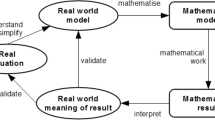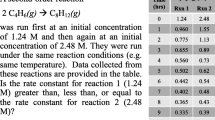Abstract
This chapter presents an example of mathematics within a multidisciplinarity context, which took place recently in Danish upper secondary school. The case’s topic was modelling a system of chemical equilibrium in a solution of molecules and ions. The teacher deliberately focused on the intertwined mathematical modelling and chemical modelling, as a means to realize a multidisciplinary teaching perspective of the two subjects. The students’ written reports were analysed with the aim to study different aspects of their perceptions of modelling, as a result of multidisciplinary teaching. Means and obstacles for support of modelling competency by multidisciplinary teaching are discussed.
Access this chapter
Tax calculation will be finalised at checkout
Purchases are for personal use only
Similar content being viewed by others
Notes
- 1.
The law of mass action: When a reversible reaction has attained equilibrium at a given temperature, the reaction quotient (the product of the molar concentrations of the substances to the right of the arrow divided by the product of the molar concentrations of the substances to the left, with each concentration raised to a power equal to the number of moles of that substance appearing in the equation) is a constant. (Holtzclaw et al. 1984 p. 4).
- 2.
The law of conservation of matter: During an ordinary chemical change, there is no detectable increase or decrease in the quantity of matter. The law of conservation of energy: During an ordinary chemical change, energy can be neither created nor destroyed, although it can be changed in form. (Holtzclaw et al. 1984 p. 4).
References
Andresen, M. (2009). Teaching to reinforce the bonds between modelling and reflecting. In M. Blomhøj & S. Carreira (Ed.), Mathematical applications and modelling in the teaching and learning of mathematics – Proceedings from TSG 21 at the 11th ICME Mexico July 6–13 2008 (p. 73–83). Roskilde, Denmark: IMFUFA.
Andresen, M., & Lindenskov, L. (2008). New roles for mathematics in multi-disciplinary, upper secondary school projects. In ZDM. The international Journal of Mathematics Education. Berlin: Springer. ISSN 1863-9690 (Print) 1863-9704 (Online) 10.1007/s11858-008-0122-z
Confrey, J., & Maloney, A. (2007). A theory of mathematical modelling in technological settings. In W. Blum, P. Galbraith, H.-W. Henn, & M. Niss (Eds.), Modelling and applications in mathematics education – The 14 th ICMI study (pp. 57–68). New York: Springer.
Holtzclaw, H. F., Robinson, W. R., & Nebergall, W. H. (1984). General chemistry. USA: D. C. Heath and Co.
Petersen, A. (2009). Ligevaegtsprojekt til DASG 1 + 2 (Equlibrium project for Danish Science Gymnasiums). Available on http://www.navimat.dk/39836/Matematik%20og%20naturvidenskab. (10.Sep 2009).
Skott, J. (2004). The forced autonomy of mathematics teachers. In Educational studies in mathematics, 55, 227–257. Netherlands: Kluwer.
Author information
Authors and Affiliations
Corresponding author
Editor information
Editors and Affiliations
Rights and permissions
Copyright information
© 2011 Springer Science+Business Media B.V.
About this paper
Cite this paper
Andresen, M., Petersen, A. (2011). Modelling Chemical Equilibrium in School Mathematics with Technology. In: Kaiser, G., Blum, W., Borromeo Ferri, R., Stillman, G. (eds) Trends in Teaching and Learning of Mathematical Modelling. International Perspectives on the Teaching and Learning of Mathematical Modelling, vol 1. Springer, Dordrecht. https://doi.org/10.1007/978-94-007-0910-2_51
Download citation
DOI: https://doi.org/10.1007/978-94-007-0910-2_51
Published:
Publisher Name: Springer, Dordrecht
Print ISBN: 978-94-007-0909-6
Online ISBN: 978-94-007-0910-2
eBook Packages: Humanities, Social Sciences and LawEducation (R0)




